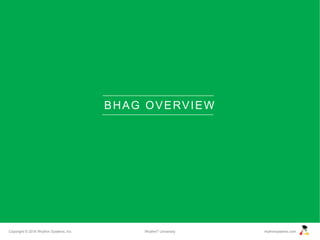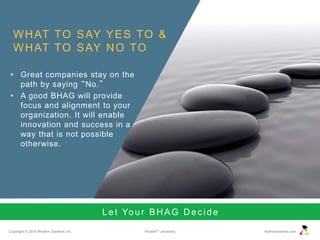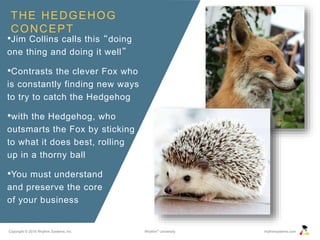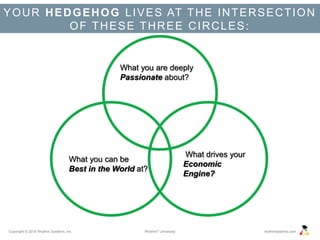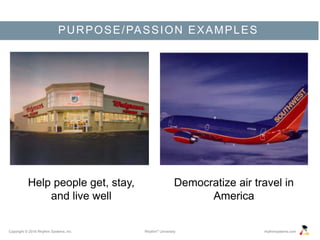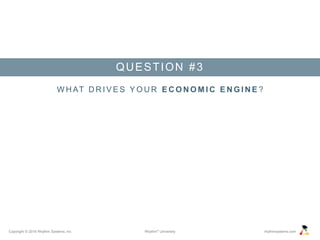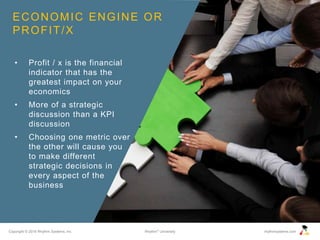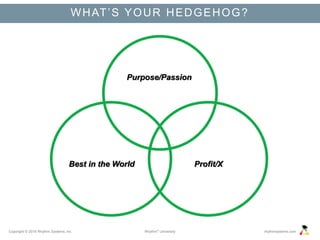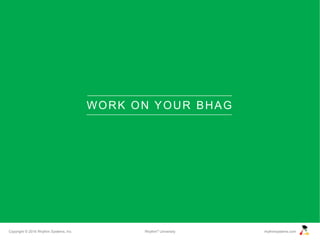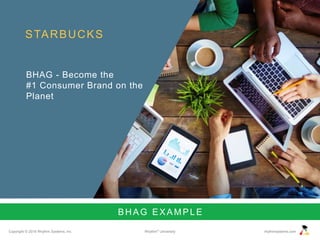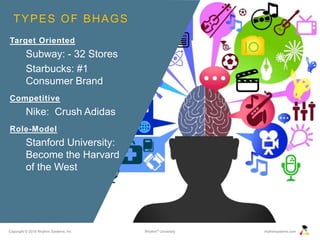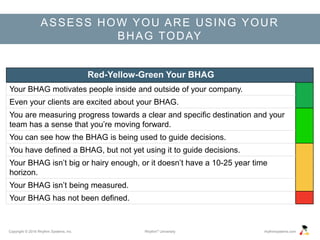BHAG for Rhythm University
- 1. Copyright © 2016 Rhythm Systems, Inc. rhythmsystems.comRhythm® University BHAG® Registered Trademark Of Jim Collins & Jerry Porras
- 2. Copyright © 2016 Rhythm Systems, Inc. rhythmsystems.comRhythm® University BHAG OVERVIEW
- 3. Copyright © 2016 Rhythm Systems, Inc. rhythmsystems.comRhythm® University WHAT IS A BHAG? • Your Big Hairy Audacious Goal • Term coined by Collins & Porras in the book Built to Last • 10+ year visionary goal • Should be daunting • Needs clear finish line • Part of your Envisioned Future
- 4. Copyright © 2016 Rhythm Systems, Inc. rhythmsystems.comRhythm® University WHY DO WE NEED A BHAG? To STRETCH us • Stretch creates energy • Necessity is the mother of invention • We should not know today how we will reach our BHAG To GUIDE us • Help us decide what to say YES to and what to say NO to
- 5. Copyright © 2016 Rhythm Systems, Inc. rhythmsystems.comRhythm® University WHAT TO SAY YES TO & WHAT TO SAY NO TO • Great companies stay on the path by saying “No.” • A good BHAG will provide focus and alignment to your organization. It will enable innovation and success in a way that is not possible otherwise. L e t Yo u r B H A G D e c i d e
- 6. Copyright © 2016 Rhythm Systems, Inc. rhythmsystems.comRhythm® University WORK ON YOUR HEDGEHOG
- 7. Copyright © 2016 Rhythm Systems, Inc. rhythmsystems.comRhythm® University THE FIRST STEP IN FINDING YOUR BHAG IS TO U N D E R S TA N D Y O U R H E D G E H O G
- 8. Copyright © 2016 Rhythm Systems, Inc. rhythmsystems.comRhythm® University THE HEDGEHOG CONCEPT • Jim Collins calls this “doing one thing and doing it well” • Contrasts the clever Fox who is constantly finding new ways to try to catch the Hedgehog • with the Hedgehog, who outsmarts the Fox by sticking to what it does best, rolling up in a thorny ball • You must understand and preserve the core of your business
- 9. Copyright © 2016 Rhythm Systems, Inc. rhythmsystems.comRhythm® University What you are deeply Passionate about? What drives your Economic Engine? What you can be Best in the World at? YOUR HEDGEHOG LIVES AT THE INTERSECTION OF THESE THREE CIRCLES:
- 10. Copyright © 2016 Rhythm Systems, Inc. rhythmsystems.comRhythm® University QUESTION #1 W H AT A R E Y O U D E E P LY PA S S I O N AT E A B O U T ?
- 11. Copyright © 2016 Rhythm Systems, Inc. rhythmsystems.comRhythm® University CORE PURPOSE • Your Organization's Reason for Being • Reflects people’s passion and idealistic motives for doing the company’s work • Captures the soul of the organization
- 12. Copyright © 2016 Rhythm Systems, Inc. rhythmsystems.comRhythm® University PURPOSE/PASSION EXAMPLES Democratize air travel in America Help people get, stay, and live well
- 13. Copyright © 2016 Rhythm Systems, Inc. rhythmsystems.comRhythm® University WORK ON YOUR CORE PURPOSE • Write down WHAT you do. • Ask "WHY is that important"? • Ask the WHY question 5 times. • Review all the different answers with your team, searching for the answer that resonates most, generates some passion, and gets to the heart of your organization's Core Purpose.
- 14. Copyright © 2016 Rhythm Systems, Inc. rhythmsystems.comRhythm® University QUESTION #2 W H AT C O U L D Y O U B E B E S T I N T H E W O R L D AT ?
- 15. Copyright © 2016 Rhythm Systems, Inc. rhythmsystems.comRhythm® University WHAT COULD YOU BE “BEST AT”? • The question is what COULD you be best at, not what ARE you already best at. • What can you NOT be best at? • It could build on a competency you already have. • Or it could be something you’re not great at today
- 16. Copyright © 2016 Rhythm Systems, Inc. rhythmsystems.comRhythm® University “BEST AT” EXAMPLES Low cost air travelConvenient drug stores
- 17. Copyright © 2016 Rhythm Systems, Inc. rhythmsystems.comRhythm® University WORK ON YOUR BEST AT • On a flipchart, write down what you know you are good at. Brainstorm ideas with your team. • Consider strengths, Core Competencies, and your Brand Promise if you have one. • Ask yourself if you could realistically become best in the world at this. • Discuss until it becomes clear. You may need to get into a Think Rhythm to continue working on ideas.
- 18. Copyright © 2016 Rhythm Systems, Inc. rhythmsystems.comRhythm® University QUESTION #3 W H AT D R I V E S Y O U R E C O N O M I C E N G I N E ?
- 19. Copyright © 2016 Rhythm Systems, Inc. rhythmsystems.comRhythm® University ECONOMIC ENGINE OR PROFIT/X • Profit / x is the financial indicator that has the greatest impact on your economics • More of a strategic discussion than a KPI discussion • Choosing one metric over the other will cause you to make different strategic decisions in every aspect of the business
- 20. Copyright © 2016 Rhythm Systems, Inc. rhythmsystems.comRhythm® University PROFIT/X EXAMPLES Profit / PlaneProfit / Customer Visit
- 21. Copyright © 2016 Rhythm Systems, Inc. rhythmsystems.comRhythm® University QUESTIONS • What drives your economic engine? • How do you make money? • Is it about the customer? The product? The service? • What has the greatest impact on the bottom line? WORK ON PROFIT/X
- 22. Copyright © 2016 Rhythm Systems, Inc. rhythmsystems.comRhythm® University Purpose/Passion Profit/XBest in the World WHAT’S YOUR HEDGEHOG?
- 23. Copyright © 2016 Rhythm Systems, Inc. rhythmsystems.comRhythm® University Purpose/Passion Profit/XBest in the World YOUR BHAG CONNECTS TO YOUR HEDGEHOG BHAG ?????
- 24. Copyright © 2016 Rhythm Systems, Inc. rhythmsystems.comRhythm® University Purpose/Passion: Democratize air travel in America Profit/X: Profit/Plane Best in the World: Providing low cost air travel SOUTHWEST AIRLINES EXAMPLE BHAG X # of airplanes in the air by X date
- 25. Copyright © 2016 Rhythm Systems, Inc. rhythmsystems.comRhythm® University WORK ON YOUR BHAG
- 26. Copyright © 2016 Rhythm Systems, Inc. rhythmsystems.comRhythm® University WORK ON YOUR BIG HAIRY AUDACIOUS GOAL W h a t i s y o u r M t . E v e r e s t ?
- 27. Copyright © 2016 Rhythm Systems, Inc. rhythmsystems.comRhythm® University BHAG GUIDELINES • Your 10+ Year Visionary Goal. It should help paint a picture of the future. • It reinforces the RIGHT Decisions because it’s connected to your Hedgehog Passion, Best At & Profit/X • It stretches us because it is Audacious: Bold, Daring, Fearless • It should Inspire us • It must be Measurable
- 28. Copyright © 2016 Rhythm Systems, Inc. rhythmsystems.comRhythm® University BHAG for 1960s America - Put a Man on the Moon & Return Him Safely BHAG EXAMPLE JOHN F. KENNEDY
- 29. Copyright © 2016 Rhythm Systems, Inc. rhythmsystems.comRhythm® University STARBUCKS BHAG - Become the #1 Consumer Brand on the Planet BHAG EXAMPLE
- 30. Copyright © 2016 Rhythm Systems, Inc. rhythmsystems.comRhythm® University TYPES OF BHAGS Target Oriented Subway: - 32 Stores Starbucks: #1 Consumer Brand Competitive Nike: Crush Adidas Role-Model Stanford University: Become the Harvard of the West
- 31. Copyright © 2016 Rhythm Systems, Inc. rhythmsystems.comRhythm® University PITFALLS TO AVOID Financial Oriented ($1B in sales) Doesn’t guide business decisions What would you say NO to? Not Connected to the Heart! Must connect emotionally Must ignite Passion Too Complicated Make it simple to understand Make it measurable
- 32. Copyright © 2016 Rhythm Systems, Inc. rhythmsystems.comRhythm® University Purpose/Passion Profit/XBest in the World SO, WHAT’S YOUR BHAG? BHAG ?????
- 33. Copyright © 2016 Rhythm Systems, Inc. rhythmsystems.comRhythm® University DOES YOUR BHAG PASS THE TEST? q Do you find this BHAG exciting? q Is the BHAG clear, compelling, and easy to grasp? q Does this BHAG somehow connect to the core purpose? q Will this BHAG be exciting to a broad base of people in the organization, not just those with executive responsibility? q Is it undeniably a Big Hairy Audacious Goal, not a verbose, hard to understand, convoluted, impossible to remember mission or vision “statement”? q Do you believe the organization has less than 100% chance of achieving the BHAG yet at the same time believe the organization can achieve the BHAG if fully committed? q Will achieving the BHAG require a quantum step in the capabilities and characteristics of the organization? q In 25 years, would you be able to tell if you have achieved the BHAG?
- 34. Copyright © 2016 Rhythm Systems, Inc. rhythmsystems.comRhythm® University BHAG NEXT STEPS
- 35. Copyright © 2016 Rhythm Systems, Inc. rhythmsystems.comRhythm® University BRING YOUR BHAG TO LIFE 1. Te l l t h e s t o r y o f y o u r B H A G s o y o u r t e a m c o n n e c t s w i t h i t e m o t i o n a l l y. 2. K e e p i t t o p o f m i n d f o r y o u r t e a m . F i n d w a y s t o p r e s e n t i t v i s u a l l y a n d f r e q u e n t l y. 3. C o n n e c t s t r a t e g y a n d e v e r y d a y e x e c u t i o n . R e v i e w y o u r B H A G e a c h t i m e y o u w o r k o n A n n u a l o r Q u a r t e r l y P l a n n i n g . 4. E v a l u a t e o p p o r t u n i t i e s w i t h y o u r B H A G ( u s e i t t o d e c i d e w h a t t o s a y y e s a n d n o t o ) . 5. Ta p t h e c r e a t i v e g e n i u s o f y o u r t e a m t o h e l p y o u fi g u r e o u t h o w t o r e a c h y o u r g o a l b y t h e d u e d a t e .
- 36. Copyright © 2016 Rhythm Systems, Inc. rhythmsystems.comRhythm® University ASSESS HOW YOU ARE USING YOUR BHAG TODAY Red-Yellow-Green Your BHAG Your BHAG motivates people inside and outside of your company. Even your clients are excited about your BHAG. You are measuring progress towards a clear and specific destination and your team has a sense that you’re moving forward. You can see how the BHAG is being used to guide decisions. You have defined a BHAG, but not yet using it to guide decisions. Your BHAG isn’t big or hairy enough, or it doesn’t have a 10-25 year time horizon. Your BHAG isn’t being measured. Your BHAG has not been defined.
Editor's Notes
- BHAG is a registered trademark of Jim Collins and Jerry Porras
- NOTE TO FACILITATOR: This is an educational slide. Your BHAG (Big Hairy Audacious Goal) is a 10-25 year goal that stretches your company to achieve greatness. Your BHAG should connect with both the Head and Heart of your organization. Head: Alignment and Focus to achieve a single goal. Heart: Emotion that makes us proud and happy to do our work. A BHAG should be a huge, daunting challenge for a company - like climbing Mount Everest. A true BHAG is clear and compelling, serves as a unifying focal point of effort, and acts as a catalyst for team spirit. It has a clear finish line, so the organization can know when it has achieved the goal; people like to shoot for finish lines.
- NOTE TO FACILITATOR: This is an educational slide. A BHAG engages people—it reaches out and grabs them. It is tangible, energizing, highly focused. People get it right away; it takes little or no explanation.
- NOTE TO FACILITATOR: This is an educational slide. Understanding your BHAG will help you to say "Yes" to the right decisions and "No" to the rest. A good BHAG will provide focus and alignment to your organization. It will enable innovation and success in a way that is not possible otherwise.
- BHAG is a registered trademark of Jim Collins and Jerry Porras
- NOTE TO FACILITATOR: This is an educational slide. The reason you need to understand your Hedgehog first is because it will help uncover your core business. You want to be sure to set a long term visionary goal for your company that You are passionate about You can be the best in the world at And drives your economic engine If you skip the Hedgehog exercise, you may set up a BHAG that leads you in the wrong direction. We recommend you don’t skip this step!
- NOTE TO FACILITATOR: This is an educational slide. For more about the Hedgehog Concept, read Good to Great Chapter 5.
- NOTE TO FACILITATOR: This is an educational slide. Key Points: This is the Hedgehog concept from Good to Great. Jim Collins uses the term Hedgehog to describe the intersection of the following three circles. “What are you passionate about?”, “What do you have the potential to be the best in the world at?” “What drives your economic engine?” The overlap of these three circles is your Hedgehog, your sweet spot. You’ll want to establish a BHAG that is connected to your Hedgehog.
- NOTE TO FACILITATOR: This is an educational slide. Purpose/Passion: What are you deeply passionate about? What activities ignite your passion? The idea here is not to stimulate passion, but to discover what makes you passionate. If you have already completed the Core Purpose Exercise, you have already discovered what you are deeply passionate about. If you haven’t discovered your Core Purpose, complete the exercise in the next slides (or you can download the DIY Deck in Rhythm University to work on your Core Purpose in more detail: http://university.rhythmsystems.com/index.php/think/discover-my-core-purpose.)
- NOTE TO FACILITATOR: This is an educational slide. Core purpose, the second part of core ideology (after Core Values), is the organization’s reason for being. An effective purpose reflects people’s idealistic motivations for doing the company’s work. It doesn‘t describe what the organization does or how it does it. It describes WHY the organization does what it does.
- NOTE TO FACILITATOR: This is an example slide. Walgreens: Help people get, stay, and live well Southwest: Democratize air travel in America More examples: 3M: To solve unsolved problems innovatively Facebook: To make the world more open and connected MobilityWorks: Making the world accessible
- NOTE TO FACILITATOR: This is an activity slide. This is a very fluid and conversational exercise; it doesn’t have to follow the exact order below, but the important thing is to get people talking, recognizing patterns, and capturing ideas. Exercise: - Start with WHAT you do. Write the statement on a flip chart or white board: "We make X products or deliver Y services” - Next, ask "WHY is that important"? Write the answer on the flip chart or white board. - Ask the WHY question again and again (up to 5 times), each time brainstorming and charting your answers. - Review all the different answers to the WHY question with your team, searching for the answer that resonates most, generates some passion, and gets to the heart of your organization's Core Purpose. The goal is to ask the question until you get to the true essence of your purpose, one that can guide the organization in the decisions it makes and attracts and motivates employees to carry out the mission. Here are some examples of the types of WHY questions that may be helpful to ask in this exercise: Why are we excited to come to work? Why did we start the business in the first place? Why do we care about our work? Why is it important to us? Why is it important to others? Why this and not something else?
- NOTE TO FACILITATOR: This is an educational slide. Best At: What could you be the best in the world at (and equally important what you can not be the best in the world at).
- NOTE TO FACILITATOR: This is an education slide. This discerning standard goes far beyond core competence. Just because you possess a core competence doesn’t necessarily mean you can be the best in the world at it. Conversely, what you can be best at might not be something in which you are currently engaged. The word COULD is important here. You may not even be great at it today, but if you were to fully commit your energy and resources to it, you Could be best in the world at it. Also, IN THE WORLD does not mean that you have to claim the world as your sandbox. You may be best in the world at delivering a product or service to a very specific geographic market. “Best in the world at building custom homes in Atlanta, GA”
- NOTE TO FACILITATOR: This is an educational slide.
- NOTE TO FACILITATOR: This is an activity slide. If you were to focus your energy, effort and resources, what could you be the very best at? It could be something you are already good at (a strength, a competence), but you have to ask the hard question: Can we really become the best at it? You must also understand what you can NOT be best at. “Doing what you are good at will only make you good. Focusing solely on what you can potentially do better than any other organization is the path to greatness.” (p. 100, Good to Great)
- NOTE TO FACILITATOR: This is an educational slide. Profit/X: What drives your Financial Engine.
- NOTE TO FACILITATOR: This is an educational slide. Profit/X: What drives your Financial Engine. The financial indicator that has the greatest impact on your economics. This is more of a strategic discussion than a KPI discussion. It should help guide strategic decisions.
- NOTE TO FACILITATOR: This is an educational slide. Examples Profit /x examples The standard retail measure is Profit per Square Foot, but Walgreens was able to stoke their economic engine by instead focusing on profit per customer visit. SW Airlines: It was about the PLANE - Profit / plane Build direct: It was about their product lines - Profit per Product line Hostopia: It was about SMB companies - Profit / SMB For more examples of Profit/X, see this blog post: http://www.rhythmsystems.com/blog/bhag-profit/x-examples
- NOTE TO FACILITATOR: This is an activity/discussion slide. Choosing one metric over the other will cause you to make different strategic decisions in every aspect of the business. Finding the right Profit per X should take a good bit of discussion and debate and may take some time. Use the questions on this slide to lead a discussion with your team about your Profit/X Ask the team to think of a few potential answers for X Then have them consider how they would make different decisions if they were trying to increase one Profit/X over another Profit/X. Try to choose something different from the most obvious industry-standard measure. Don’t worry about how you will actually measure it right now.
- NOTE TO FACILITATOR: Now that you have answered the 3 questions to get to your Hedgehog, put it all together. You can use this slide or draw a diagram on your flipchart to record your answers to these questions to summarize your Hedgehog discussions. Talk about examples of work that you currently do that satisfies all three circles. You may also want to talk about work that you currently do that falls into 1 or 2 of the circles, but not all 3. This will help you distinguish between the Hedgehog (your core business) and other business that you currently do. Discovering your Hedgehog does not mean that you need to walk away from all business that doesn’t satisfy all three circles. It simply helps you identify the core business that you want to invest in and develop for the future. If you identified any business you’re currently doing that doesn’t fall into any of the 3 circles, pause and ask yourself why you’re doing that. This may be something you can stop doing.
- NOTE TO FACILITATOR: This slide illustrates how the BHAG comes out of the discussions you’ve just had with your team. Connecting your long term visionary goal to your Hedgehog ensures that as you continue to drive toward your BHAG, you will be driving on the core elements of your strategy – work that you are passionate about, work that you can be best in the world at, and work that drives your economic engine.
- NOTE TO FACILITATOR: This is an educational slide. This illustrates an example of how the BHAG comes out of the Hedgehog discussion. Walgreens has not published their BHAG, but we do know that their vision is be America's most loved pharmacy-led health, wellbeing and beauty enterprise. Based on their Hedgehog (the examples in the deck above), we might guess that they would measure this vision based on the number of customer visits (possibly in comparison to competing stores) to know they’ve become “the most loved.”
- BHAG is a registered trademark of Jim Collins and Jerry Porras
- NOTE TO FACILITATOR: This is an educational slide. Now that you have your Hedgehog, it is time to work on your BHAG.
- NOTE TO FACILITATOR: This is an educational slide. A true BHAG is clear and compelling, serves as a unifying focal point of effort, and acts as a catalyst for team spirit. It has a clear finish line, so the organization can know when it has achieved the goal; people like to shoot for finish lines. A BHAG engages people—it reaches out and grabs them in the gut. It is tangible, energizing, highly focused. People get it right away; it takes little or no explanation. KEEP IN MIND: this is NOT a word-smithing exercise. This is an exercise to set a goal—to pick the mountain you are trying to climb—not to create a perfect “statement.” In fact, the goal should be something that could be expressed multiple ways, yet still be the same goal. Certainly, some phrases inspire more than others, but the point is that the goal itself counts most. The BHAG process is not about sloganeering or word-smithing. It is about goal setting. It is about picking a goal that will stimulate change and progress and making a resolute commitment to it. This is not about writing a “mission statement.” This is about going on a mission! This is also a process. It takes many months to gain the understanding of your business you need to choose the right BHAG. TIP: If you are stuck on how to make your BHAG measurable, use your Profit/X
- NOTE TO FACILITATOR: This is an educational slide. Key Points: JFK - Put a man on the moon and return him safely Emotional and inspiring - gripped the nation Head/Business/Logic - birthed technology - put USA ahead of the world Heart- motivates you to achieve greatness you would not achieve otherwise JFK announced the goal to congress in 1961 and set the due date of the end of the decade to accomplish it. They reached the goal July 20, 1969.
- NOTE TO FACILITATOR: This is an educational slide. Starbucks - #1 Consumer Brand on the Planet - BTW, It took them nearly a year to figure this out - with Jim Collins himself as their coach! Their original BHAG was 2000 stores by the year 2000. Jim Collins challenged them because it wasn’t far enough out, and they were too close to achieving it. They worked for 6 months on finding the right BHAG and finally settled on Becoming the #1 Consumer Brand on the Planet. Think about the effect that has had. Again, the focus away from store number has allowed them to do things like offer Starbucks ice cream, sell their coffee on airplanes and brand Starbucks music in their cafes, and last year we saw them closing unprofitable stores. That would have been a lot harder if they were focused on achieving a total store count. Here’s a link to a 2 minute audio clip of Jim Collins telling his story of working with Starbucks on their BHAG: http://www.jimcollins.com/media_topics/building-greatness.html#audio=60
- NOTE TO FACILITATOR: This is an educational slide. More Examples: Target BHAGs can be quantitative or qualitative Become a $125 billion company by the year 2000 (Wal-Mart, 1990) Democratize the automobile (Ford Motor Company, early 1900s) Become the company most known for changing the worldwide poor-quality image of Japanese products (Sony, early 1950s) Become the most powerful, the most serviceable, the most far-reaching world financial institution that has ever been (City Bank, predecessor to Citicorp, 1915) Become the dominant player in commercial aircraft and bring the world into the jet age (Boeing, 1950) Competitive/Common-enemy BHAGs involve David-versus-Goliath thinking Knock off RJR as the number one tobacco company in the world (Philip Morris, 1950s) Crush Adidas (Nike, 1960s) Yamaha wo tsubusu! We will destroy Yamaha! (Honda, 1970s) Role-model BHAGs suit up-and-coming organizations Become the Nike of the cycling industry (Giro Sport Design, 1986) Become as respected in 20 years as Hewlett-Packard is today (Watkins-Johnson, 1996) Become the Harvard of the West (Stanford University, 1940s) Internal-transformation BHAGs suit large, established organizations Become number one or number two in every market we serve and revolutionize this company to have the strengths of a big company combined with the leanness and agility of a small company (General Electric Company, 1980s) Transform this company from a defense contractor into the best diversified high-technology company in the world (Rockwell, 1995) Transform this division from a poorly respected internal products supplier to one of the most respected, exciting, and sought- after divisions in the company (Components Support Division of a computer products company, 1989)
- NOTE TO FACILITATOR: This is an educational slide. Don’t confuse a BHAG with a core purpose. A BHAG is a clearly articulated goal that is reachable within 10 to 30 years. But your core purpose is completely aspirational… it could never be completed.
- NOTE TO FACILITATOR: This is an exercise slide. If yours is a private company, it is important to include the owner in this conversation. Ask the team to visualize what they would like the company to look like in 10-25 years. What is the ultimate definition of success? Describe what the business would look like when you achieve this success. How many employees, customers, locations? What magazines or other publications are writing about you? Who’s talking about you and what are they saying? What are the headlines? What awards have you won? So what would be a way to measure this success? Consider your Profit/X. Have the team brainstorm specific suggestions for potential BHAGs. This is probably not a conversation that can be concluded in just one session. You may need to set up a Think Rhythm to continue working on potential ideas.
- NOTE TO FACILITATOR: This is an activity/discussion slide. Test the BHAG against the questions on this slide. If you cannot answer “Yes” to each of the these questions, then you have not yet succeeded in developing a good BHAG. When you have created a BHAG to which two-thirds of the group can answer “Yes” to all questions, you are ready to move on. You may narrow it down to two or three potential BHAGs and agree to revisit it again next quarter. Because the BHAG is part of setting the company’s vision, it’s important that the potential BHAGs are aligned.... that they are painting a picture of the same future, just struggling with how best to state it or measure it. If you see that the potential BHAGs are mutually exclusive, meaning that if you strive for one, you will have to abandon another, then you need to bring this out and have the team get clear on where they want to be in 10-20 years. How big do they want to be? How far do they want to reach? These tests come from Jim Collins’ Vision Framework: http://www.jimcollins.com/tools/vision-framework.pdf
- BHAG is a registered trademark of Jim Collins and Jerry Porras
- NOTE TO FACILITATOR: Now that your BHAG has been discovered and tested, what’s next? You will need to roll it out to the rest of your company. You can stay on a path of progress of using and testing it to see if it excites your team and helps them make decisions. Here are some ways to use them and keep them top of mind for your team. Decide on a few things to do now to begin using them in your company, and revisit this list periodically so you can continue to integrate them into your company’s daily life. For more information on How to Reach Your BHAG, see this blog post: http://www.rhythmsystems.com/blog/how-to-reach-your-bhag-infographic
- Working on your long term strategy is a journey rather than an event. Discovering and using your BHAG is an iterative process. If you or your team falls into the Red or Yellow or just haven’t been able to get to SuperGreen on your BHAG , you can get in a Think Rhythm to continue working on your BHAG. Contact your coach if you need help discovering or finding the best ways to use your BHAG as a foundation to help you grow with purpose.

